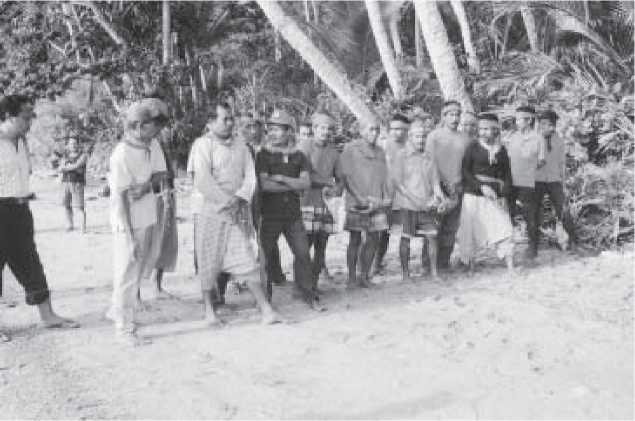The KUD has no decision-making role, but has an economic interest, especially now that it
organizes the harvest and division of the catch. The KUD officials and the members (to a
lesser extent) share in the catch/revenues. The common villagers play no active role in sasi
and are merely recipients of the indirect benefits derived from sasi.
Sasi is clearly a village-based institution. Outside organizations are not involved in sasi or
decision-making. The police will only interfere on the request of the village head.
10.4.2 Ceremonies for marine sasi
The decision to close sasi is made by the village head and the head of the kewang. To close sasi,
the kewang members gather in the house of the pakter (kewang leader), then proceed to the
village head’s house and from there to the Baileo or community house. At each street corner, a
kewang member blows the sea shell, while the head of the kewang announces the sasi regulations
(specific products and places). After the sasi signs (palm fronds tied to a stick) are put up, the
ceremony is proclaimed over and sasi is closed.
When sasi is opened, there is a communal prayer in the office of the village government where
villagers await the arrival of the attendants for “buka sasi”. The real ceremony to open marine
sasi takes place at the sea-shore near the sasi area. With the village officials and kewang in
attendance, the tuan negeri makes a speech explaining how important sasi is and how the
kewang is responsible for guarding the area. This is followed by a prayer by the minister. All
the players (village government, traditional and religious leaders, and the kewang members)
then go out to sea, where the minister prays again for a rich harvest. The village head utters
an invocation in the traditional language and then sprinkles fresh water over the sea as a
symbolic gesture. Sasi is declared open. Skin divers, hired through the village cooperative,
harvest at least three top shells and there is a break during which everyone rests and eats a
traditional feast (patita) provided by whoever has won the auction for harvest rights. Then
the divers continue their work (see Figures 10.2-10.10).

Figure 10.2. Village authorities, Kewang menbers, and invitees
gather on the beach
106 An Institutional Analysis of Sasi Laut in Maluku, Indonesia
More intriguing information
1. PROPOSED IMMIGRATION POLICY REFORM & FARM LABOR MARKET OUTCOMES2. The name is absent
3. Wirtschaftslage und Reformprozesse in Estland, Lettland, und Litauen: Bericht 2001
4. The name is absent
5. Antidote Stocking at Hospitals in North Palestine
6. Elicited bid functions in (a)symmetric first-price auctions
7. The name is absent
8. The name is absent
9. Foreign Direct Investment and Unequal Regional Economic Growth in China
10. Industrial Employment Growth in Spanish Regions - the Role Played by Size, Innovation, and Spatial Aspects